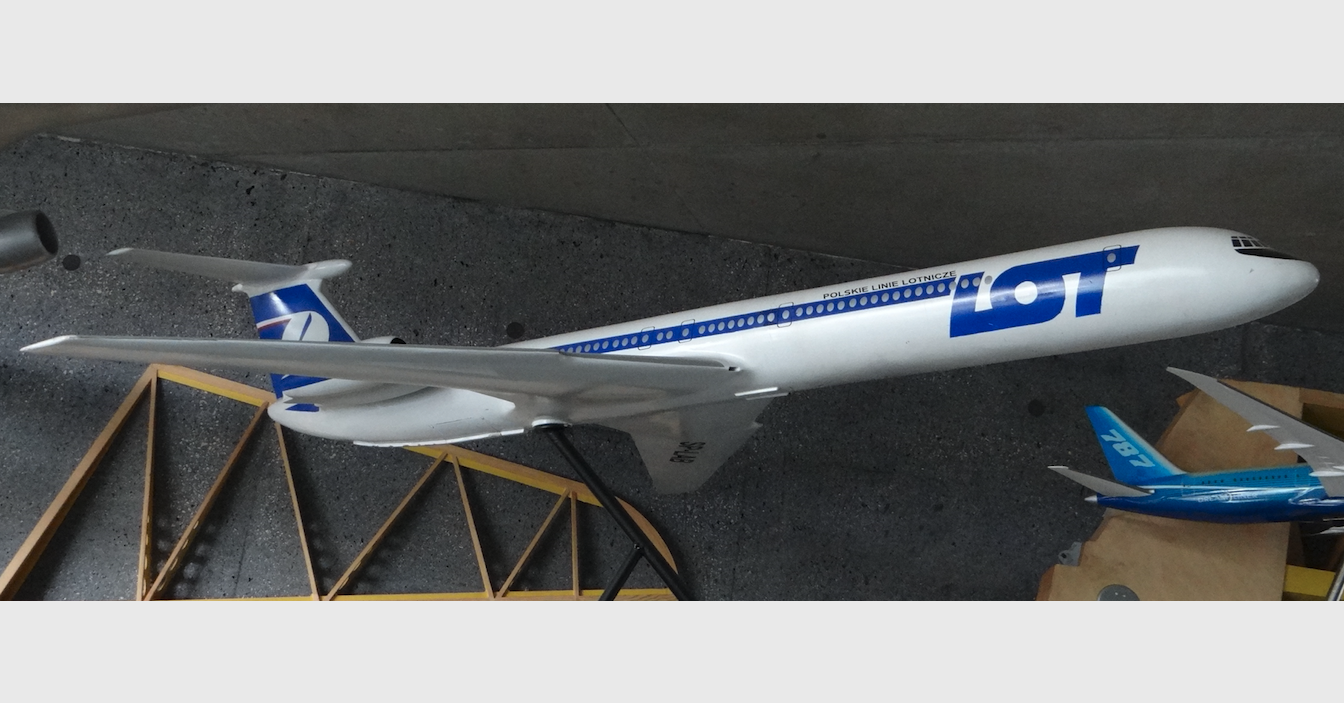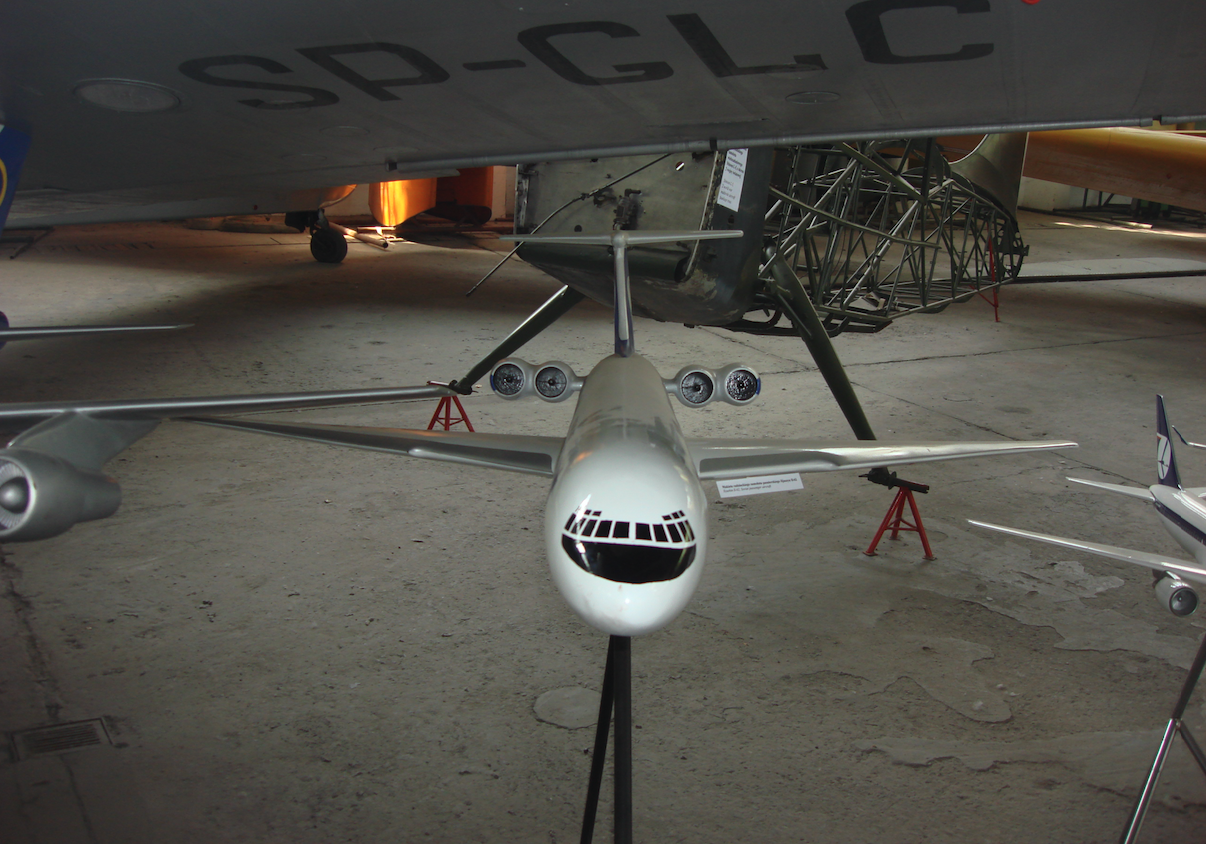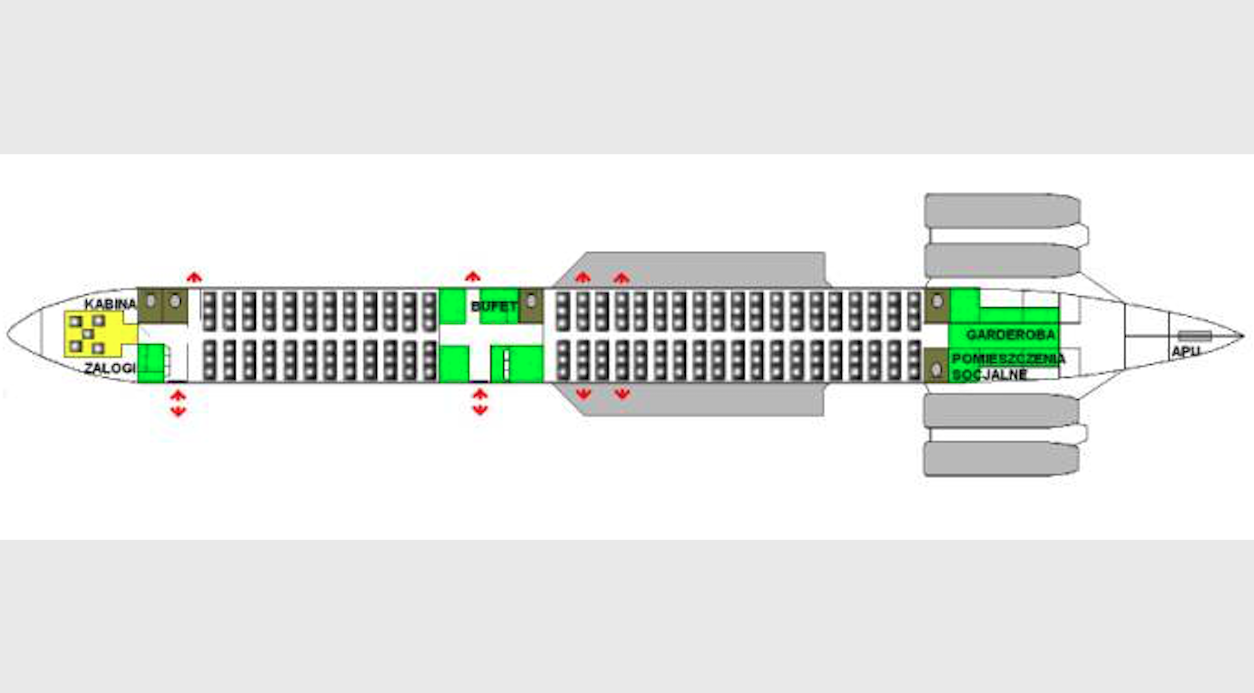Kraków 2009-06-15
Construction
229b Section 21.03.1972 year.
OKB Iliuszyn Ił-62 / Ił-62 M in Poland.
The Il-62 is a long-haul airliner. Built in a classic layout, low-wing, powered by 4 twin-flow turbojet engines.
Wings oblique with a span of 43.20 m. The leading edge has a bevel angle of 32.5 degrees. The angle of the wing in ¼ of the chord is 35 degrees. There is a step near halfway along the leading edge. It plays the same role as the aerodynamic steering wheel on the wing, i.e. to stop the flow of air flowing along the wing. This solution was not widely used on Russian aircraft. The rule was aerodynamic steering, which further strengthen the wing structure. The trailing edge is broken and the part by the hull is perpendicular to it. The wings are classically equipped with flaps, ailerons and breakers. Ailerons occupy about 40% of the trailing edge. Two-piece flaps, wideners, slotted, mounted on three knots each. They are tilted to take-off 20 degrees, for landing a maximum of 40 degrees. The breakers are two-piece and located in front of the outer flaps. They act as aerodynamic brakes. The ends of the wings are rounded. There are 7 integral fuel tanks in the wings.
Comparing the Il-62 wings with the VC-10 is definitely in favor of the latter. Mechanization is much richer. Almost the entire leading edge of the leading edge has front flaps. The rear flaps are four-piece multi-slotted. Three-section circuit breakers. In addition, the wings have the same shape, profile and wedge angle.
The fuselage of an airplane with a circular cross-section. It begins with a cover that is lifted upwards and covers the avionics equipment, including the weather radar station. The crew cabin was glazed with 18 windows. Directly in front of the pilots, two windows are the largest and equipped with an external wiper. The cabin is relatively spacious, but has to accommodate as many as five pilots. The captain-commander of the ship takes the left seat, the right one is the co-pilot. Behind them they sit; navigator, radio operator and flight engineer. The center seat is located exactly in the center of the cabin. A mechanic takes the place here. It is rotatable to make it easier for other crew members to take their seats. The seats are adjustable. They have foldable armrests. The seats are of course upholstered and equipped with lap belts. They are comfortable by the local standards. The crew cabin is separated from the rest of the cabin by a partition with doors. There is a compartment with avionics equipment, toilets, a break room and the front main entrance door. Next is the front passenger cabin. This cabin was often divided into the front and rear part of other carriers. In the front there were seats for the business class in the arrangement of 4 wide seats in a row. In the rear, there are already 6 seats in a row in the economy or tourist class. In LOT Polish Airlines, all the seats had 6 seats in a row, only with a different distance between the rows. By default, it was the economy class of 12 rows, i.e. 72 passenger seats. Behind the front cabin there are social rooms with a buffet-kitchen, toilet, second main door and others. Next, there is the rear economy class passenger cabin arranged in 19 rows, 6 seats each, i.e. 114 seats. In the tail part of the plane there are two more toilets, a wardrobe and rest rooms for flight attendants. At the very end of the fuselage there is an APU, i.e. a turbo generator. Passenger seats were relatively comfortable at that time. Adjustable backrests. The backrests had a fold-out table for the passenger in the rear seat. Overhead passengers had lockable containers for hand luggage, individual air vents, a novelty in Soviet planes. A large number of windows made the Il-62 the first Polish passenger plane where each passenger sitting by the window had a perfect view outside. In the front cabin, each side of the cabin has 18 windows (with 12 rows of seats), the rear cabin has 27 windows on each side (with 19 rows of seats). So passengers have 90 windows at their disposal. There were no such situations, like on board An-24 or Tu-134, when the passenger sitting by the side did not have a window. This is further evidence of the VC-10 design being followed. In the standard configuration, the Polish Ił-62 / M took 186 passenger seats, five airmen and five flight attendants on board. In addition to the main doors, the plane received emergency exits. Four with wing exits and two on the starboard side with inflatable gangways. The main doors also have emergency hatchways. As in the Il-18 plane, the Il-62 plane is a double-decker plane. The lower deck acts as a boot and of course has both the front and main undercarriage compartments.
The tail in the shape of the letter "T", oblique. Vertical with division into stabilizer and rudder. In the Il-62 M version, the interior of the vertical tail was used for another fuel tank. Vertical, also divided into fins and elevator. The entire vertical tail has a variable wedge angle, i.e. it is a floating tail.
Classic chassis. Front with double wheels, retractable into the fuselage. The main chassis is four-wheeled carts. The legs are supported in the wings and the wheels retract into the fuselage (center wing). The base of the landing gear is 24.49 m, the spacing of the main landing gear is 6.80 m. An interesting and effective solution is to supplement the landing gear with an additional leg with two wheels at the rear. It is also completely retractable into the hull. It protects the rear part of the fuselage during take-off and landing. Then only the wheels are extended. However, during a stop at the airport, the shin with the wheels is fully extended and then it acts as a support so that due to inadvertence (excessive overloading of the back of the cabin) the plane does not sit on its tail.
The airframe service life of the Il-62 / M aircraft was calculated at 23/25 years, 8,500 / 8,500 landings, 35,000 / 45,000 hours. We can easily see that the plane was made according to military standards, which should not be surprising, as the Russians did not have civil standards.
The drive unit Ił-62 / M.
The power unit was placed at the rear of the fuselage, in pairs on both sides of the fuselage. The axes of the engines were placed; in top view – parallel to the fuselage axis, in side view – tilt so that the exhaust nozzles eject the gases slightly downwards. This solution slightly increases the lift. This powertrain layout has pros and cons. The pluses include a slight asymmetry of thrust when one or even two engines are cut on one side. We learned about the disadvantages of such a system after analyzing the disasters. The engine is numbered from the left. The engines No. 1 and 4 were equipped with thrust reversers, regardless of the engine type. The design of the thrust reversers varies according to the type of engine. The Polish Il-62s were powered by engines from the office of Nikolai Kuznetsov NK-8-4 with a thrust of 4 x 10 408 daN (4 x 10 610 kG). Overall length 5,288 m, max diameter 1,442 m, total weight 2,350 kg, take-off line 1 x 102,963 kN.
Engine design; the engine is a two-flow, two-shaft, turbo-fan. It starts with a 2-stage fan on the first shaft. The air is then split into two flows. There is a 2-stage compressor of the first shaft in the internal flow. Then there is a 6-stage compressor on the second shaft. Ring-pitcher combustion chamber. Behind it, a 1-stage high-pressure turbine of the second shaft and a 2-stage low-pressure turbine of the first shaft. Next, the outlet nozzle with or without a draft reverser. Aerodynamic blades are placed between the individual stages of the fan and the compressor. The engine equipment and the thrust reverser actuator are located in the lower part. Oil reservoir in the upper side.
The Polish Il-62 M engines were powered by engines from the Soloviev D-30 KU office with a thrust of 4 x 107.9 kN, 4 x 11 282 daN (4 x 11 500 kG). The motor’s double-flow rate is 2.54.
Dane T-T Ił-62:
| Dane T-T | Ił-62. 1972r. | Ił-62 M. 1979r. | Miano |
|---|---|---|---|
| Rozpiętość | 43,20 | 43,20 | m |
| Długość | 53,12 | 53,12 | m |
| Wysokość | 12,35 | 12,35 | m |
| Powierzchnia nośna | 279,5 | 279,5 | m2 |
| Masa własna | 70 000 | 67 500 | kg |
| Masa całkowita | 161 600 | 167 000 | kg |
| Masa ładunku | 97 500 z paliwem | kg | |
| Masa frachtu | 23 000 | 23 000 | kg |
| Paliwo | 101 000 | 105 300 | litrów |
| Prędkość maksymalna | 890 | 900 | km/h |
| Prędkość wznoszenia | 16,5 | 16,8 | m/s |
| Prędkość przelotowa | 850 | 855 | km/h |
| Prędkość lądowania | 300 | 300 | km/h |
| Prędkość przyziemienia | 240 | 240 | km/h |
| Zasięg maksymalny | 9 200 | 10 000 ze 100 pasażerami | km |
| Zasięg z ładunkiem 50 % | 8 000 | 8 300 | km |
| Zasięg z ładunkiem 90 % | 6 700 | 7 800 | km |
| Pułap maksymalny | 12 000 | 12 000 | m |
| Pułap przelotowy | 8 000 – 10 000 | 8 000 – 10 000 | m |
| Rozbieg | 2 930 | 2 250 | m |
| Dobieg minimalny | 1 000 | 1 000 | m |
| Silniki typ | NK-8-4 | D-30 KU | |
| Ciąg silników | 4 x 10 500 kG | 4 x 107,9 kN | |
| Liczba pasażerów | 168 – 186 | 168 – 186 | |
| Liczba samolotów w PLL LOT | 7 | 9 |
Tally
Iliuszyn Ił-62:
- SP-LAA No. 11004, March 21, 1972. The plane was named after Nicolaus Copernicus. On March 14, 1980. crashed while approaching Okęcie.
- SP-LAB no. 21105, April 1972. The plane was named Tadeusz Kościuszko. In November 1982, the CCCP was returned.
- SP-LAC No. 31401, March 1973. The plane was named Fryderyk Chopin. In June 1982, the CCCP was returned.
- SP-LAD No. 41604, April 1974. The plane was named Kazimierz Puławski. In April 1983, the CCCP was returned.
- SP-LAE No. 41802, December 1974. The plane was named after Henryk Sienkiewicz. In September 1983, the CCCP returned.
- SP-LAF No. 62204, May 1976. The plane was named Adam Mickiewicz. In May 1983, the CCCP was returned.
- SP-LAG No.2725456, May 1977. The plane was named Maria Skłodowska-Curie. In June 1983, the CCCP returned.
- CCCP-86450 No. 52104. Borrowed for PLL LOT from Aeroflot in the period from April 1980. until October 1980.
- CCCP-88610 No. 41801. Borrowed for PLL LOT from Aeroflot in the period from March 1985. until October 1985
- CCCP-86611 No. 41803. Borrowed for PLL LOT from Aeroflot in the period from May 1984. until September 1985.
- CCCP-86663 No. 50103. Borrowed for PLL LOT from Aeroflot in the period from May 1978. until September 1979.
Iliuszyn Ił-62 M:
- SP-LBA No. 2932526, April 1979. The plane was named Janusz Kusociński. In January 1992. sold to Ukraine.
- SP-LBB No. 1034152, February 1980. The plane was named Ignacy Paderewski. In January 1992. sold to Ukraine.
- SP-LBC # 3036253, October 1980. The plane was named after Joseph Conrad-Korzeniowski. In January 1992. sold to Ukraine.
- SP-LBD No. 1138234, March 1981. The plane was named after Gen. Władysław Sikorski. In January 1992. sold to Ukraine.
- SP-LBE No. 1138546, April 1981. The plane was named Stanisław Moniuszko. In February 1992. sold to Ukraine.
- SP-LBF No. 2343554, July 1983. The plane was named Fryderyk Chopin. In February 1992. sold to Ukraine.
- SP-LBG No. 3344942, April 1984. The plane was named Tadeusz Kościuszko. On May 9, 1987, it crashed in the Kabicki Forest due to a failure.
- SP-LBH No. 1748445, July 1987. The plane no longer received its own name. Sold to Ukraine in February 1992.
- SP-LBI No. 4831739, June 1987. Aeroflot aircraft delivered to replace the lost SP-LBG. In CCCP nb CCCP-86504.SP-LBR No. 4727546. The plane was loaned to LOT from Tarom YR-IRD in the period from May 1986. until May 1987.YR-IRE No. 4831628. The plane was loaned to LOT from Traom in the period from May 1984. until December 1985.
Opracował Karol Placha Hetman



